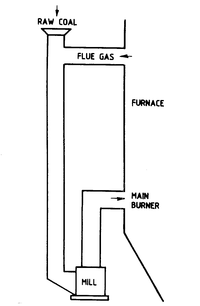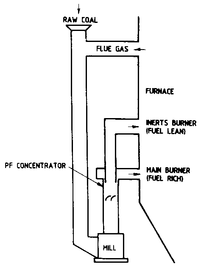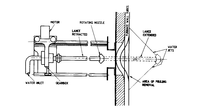


Chapter 6
I Construction During The Settlement Years
II The Use Of Timber As A Structural Material
III Structural Steel
IV Concrete Technology
V Housing
VI Industrialised Pre-cast Concrete Housing
VII Ports And Harbours
VIII Roads
IX Heavy Foundations
X Bridges
XI Sewerage
XII Water Engineering
XIII Railways
XIV Major Buildings
XV Airports
XVI Thermal Power Stations
i Steam Power Stations Using Brown Coal
ii Fabric Filters for Coal Fired Power Stations
iii Thermal Electricity Generation in Queensland
iv Conversion of Kwinana Power Station from Oil to Coal Firing
v Remote Area Power Supply Alternatives in Western Australia
XVII Materials Handling
XVIII Oil Industry
XIX The Snowy Mountains Scheme
XX The Sydney Opera House
XXI The Sydney Harbour Bridge
XXII Hamersley Iron
XXIII North West Shelf
Sources and References
Index
Search
Help
Contact us

Steam Power Stations Using Brown Coal
Of necessity Victoria has developed its power industry based on the indigenous brown coal which exists in very large quantities in the La Trobe Valley. The State Electricity Commission of Victoria was given the responsibility for developing this coal for electricity generation, and a network of open cuts and power stations has been built up in the La Trobe Valley some 160 km east of Melbourne.The technology for this plant was based on German experience, where the power industry was also based on brown coal. The Victorian brown coal, however, possessed some different characteristics, particularly its generally higher water content which significantly lowered its heating value and made it much more difficult to burn. In general, its use resulted in larger and more costly boilers, with necessary design variations to the combustion equipment to handle the wetter coal.
Separation Firing
Progressively improved designs achieved satisfactory combustion in the smaller grate fired boilers of the early stations. When pulverised fuel firing was introduced at Yallourn Power Station in 1954, however, the higher water content of the coal showed up major deficiencies in the combustion system, with combustion instability and flame-outs being a common occurrence. This was subjected to a major investigation and was solved through the development and installation of separation firing by the boiler contractor John Thompson of Australia and their sub-contractors, International Combustion of Australia (ICAL). The invention was attributed to J. Markstein of ICAL and a world patent was taken out. The following briefly describes the original and modified systems, Figs. 60 and 61 respectively:


Based on the German experience the original system incorporated a hot flue gas recirculating system in which both drying and pulverising takes place in the mill. Discharge of the pulverised fuel to the single burner, however, was accompanied by the inert flue gases and water vapour, and these seriously impaired combustion at the burner. This effect was much worse for the Victorian brown coal because its higher water content resulted in higher quantities of flue gas and water vapour at the burner mouth.
The modification implemented by the contractor is shown in Fig. 61. This introduced a centrifugal separation system which delivered some 85 per cent of the pulverised fuel and 25 per cent of the gases to a separate lower or main burner, with the remaining 15 per cent of the fuel and 75 per cent of the gases passing to an upper or 'inerts' burner. This conferred stable operation to the furnace as a result of the fuel-rich mixture supplied to the main burners.
All subsequent plants using the higher moisture LV coal, including the recent 500 MW units at Loy Yang A, have incorporated this feature.
Boiler Fouling
Although the ash content of the Victorian brown coal is relatively low, certain constituents of the ash, particularly sodium, have caused major difficulties with fouling of boiler heating surfaces. The Yallourn coals used in the early stations did not generally exhibit this feature but heavy fouling was unfortunately experienced in the later Morwell boilers, which used coal from a new open cut (1960s) at Morwell. A little later the seriousness of this problem was heightened by similar effects in the Hazelwood 200 MW boilers using the same coal. The conventional steam blowers were ineffective in the furnace and boiler fouling occurred so rapidly that shut-downs were necessary at three weekly intervals for off-load cleaning. This problem led to one of the earlier applications of remote operated fixed water blowers in the furnace, which substantially increased the period between boiler cleans. The blowers were based on an East German Sphur design, but a number of modifications and improvements were made to improve reliability and effectiveness. Subsequent developments of water blowers were influenced by this work. A sketch of the modified blower as still used in the Hazelwood boilers is shown in Fig. 62.

Organisations in Australian Science at Work - International Combustion of Australia (I.C.A.L.); John Thompson of Australia; State Electricity Commission of Victoria (S.E.C.); thermal power stations, named; thermal power stations, named; thermal power stations, named
People in Bright Sparcs - Markstein, J.; Sutherland, K. N.
 |
Australian Academy of Technological Sciences and Engineering |  |
© 1988 Print Edition pages 398 - 399, Online Edition 2000
Published by Australian Science and Technology Heritage Centre, using the Web Academic Resource Publisher
http://www.austehc.unimelb.edu.au/tia/395.html